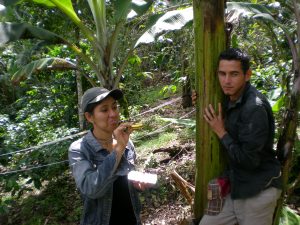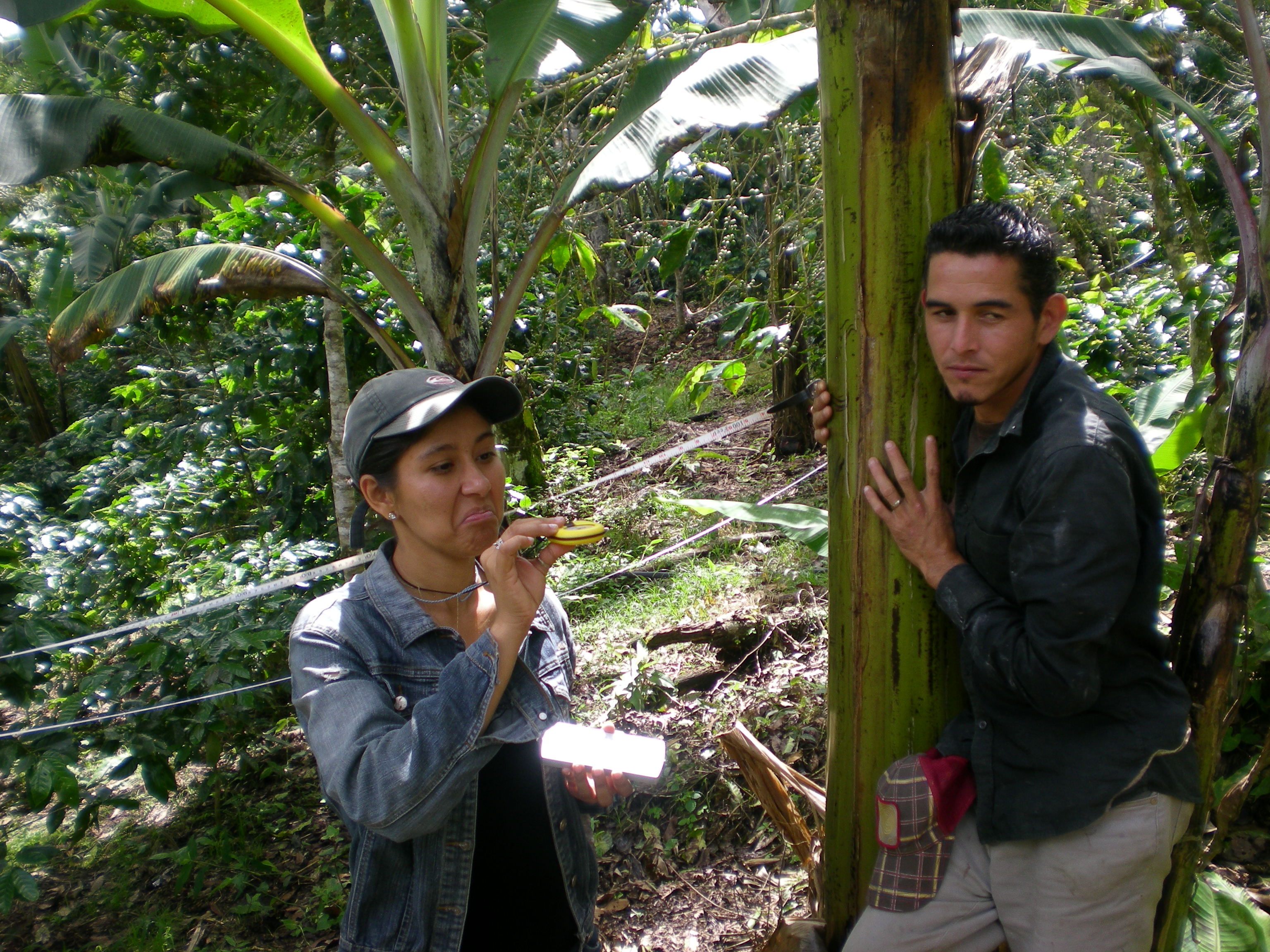
I’m hunched over my precious data notebook, trying desperately to scribble down the series of numbers being shouted to me in Spanish. Although my field assistant is less than ten feet away, I can barely hear him over the roar of rain beating against the trees and coffee plants around us. The farmer who owns this plot of shade coffee in the mountains of Jinotega, Nicaragua stands next to me, holding a banana leaf over our heads as a makeshift umbrella. Our clothes are soaked through and water has begun to pool in the toes of my rubber boots, but the notebook stays dry. Or at least, dry enough.
A month later, I’m sitting in the sleek downtown offices of the International Center for Tropical Agriculture (CIAT) Nicaragua, turning this series of numbers into a computer simulation of the farm, each tree recreated as a neon-colored cartoon in a gray-and-white grid. The office in Managua is several hours by bus from Jinotega, though it seems to be almost a different country. CIAT Nicaragua is staffed by scientists from around the world, gathered in these offices to work toward the organization’s mission of making more efficient use of natural resources in order to create sustainable livelihoods across the tropics.
A diversity of experiences
My internship with CIAT was marked by extremes like these. Throughout the course of data collection and analysis, I visited 70 coffee farms surrounding the city of Jinotega. One day I was soaked in DEET, sliding down muddy hills and pulling coffee berries out of my pockets and shoes. Another, I stood nervously in front of coffee cooperative members, representatives of Cafenica, and researchers from the University of Nicaragua Leon—people much more important, knowledgeable, and fluent in Spanish than I am, listening to me present the preliminary results of my study on carbon storage in Jinotega’s shade coffee farms.
La presentación comienza
I wasn’t any more prepared for this presentation than I had been for that rainstorm in the coffee field a few weeks before. I found out about this meeting on very short notice, and had only a few hours to prepare. This time last year, that alone would have filled me with dread. On top of that, I was going to be presenting in Spanish, a language I haven’t studied in seven years. If you know me, you know I’d agree to slide down a hundred muddy hills before I signed up to give this twenty-minute talk.

As I sat down to draft my presentation, I thought back over my first year of coursework at the Bard CEP, suddenly very grateful for all the time we devoted to public speaking and thinking on our feet. As much as I hated those workshops, they gave me the tools I needed to stand up, make eye contact, and hit play on my Powerpoint that morning.
The presentation wasn’t flawless. I stumbled over my words more than once. But I managed to get my point across, and communicate to the group that the farms in our study did seem to be storing a lot of carbon, keeping that greenhouse gas out of the atmosphere and playing a role in mitigating climate change. With some relatively simple field methods and a statistics code that my supervisor and I put together, local researchers can continue this project, monitoring carbon storage over time.
Where it’s all heading
Hopefully, my results will be useful in the development of a carbon payment program. In addition to incentivizing sustainable farming practices, this would provide cash rewards to farmers for the valuable ecosystem service their shade trees perform. My computer models will help officials develop recommendations for increasing carbon storage without creating so much shade that understory coffee plants stop producing fruit. This will serve not only coffee drinkers like me, but also coffee farmers like the cheerful old man who held a banana leaf over my head to keep me almost dry during a torrential downpour.

Vanessa-
Well done adapting on the fly to deliver an important presentation! As I remember from Oaxaca, your Spanish is a lot better than you may realize!
The amount of data that went into your model sounds huge! Was the primary purpose of the model to look at spacing requirements for an optimum coffee-to-carbon-storage ratio or was it to try and calculate the amount of carbon storage at each of the farms? What were some of your findings from all your data collection efforts?
You’ll have to give me your recommendation for your favorite Nicaraguan, shade-grown coffee!
~Collin